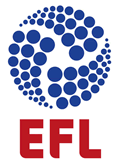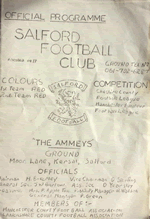News & Updates Archive 2021
24 December
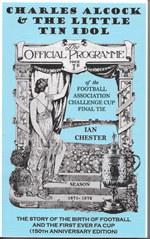 As HFK frequent flyers will know, from time to time I like to review books that cross my desk that are connected to the history of association football, especially if I have made some minor contribution. Today I should like to feature Charles Alcock & the Little Tin Idol, written and published by Ian Chester.
As HFK frequent flyers will know, from time to time I like to review books that cross my desk that are connected to the history of association football, especially if I have made some minor contribution. Today I should like to feature Charles Alcock & the Little Tin Idol, written and published by Ian Chester.
Charles William Alcock was one of the most influential figures in the early history of the game. After leaving Harrow School in 1859 he and his brother, John Forster Alcock, founded London's first football club Forest FC. Charles was the prime mover in the formation of Forest's famous successor, Wanderers FC. He captained the England team in all five matches against a Scotland XI between 1870 and 1872 although these are not recognised as full internationals. He also captained The Wanderers when they won the first ever FA Cup final in 1872. He served on the FA Committee 1866-1870 before being appointed as FA Secretary, a post he held until 1895. In April 1871 Alcock proposed to establish the FA Cup and he was instrumental in organising the first official international match against Scotland in 1872.
Ian Chester follows the early career of Charles and provides an overview of the development of the game including brief histories of the teams that entered the first FA Cup. The second half of the book is devoted to match-by-match reports from the competition itself.
The important thing to say about this book is that it is not a conventional history. As Chester writes in the Foreword, the book "is an attempt to use the historical information of the time to paint a picture of what it was like to play the game at its conception in Victorian society." The known facts form a structure around which the author weaves a more detailed narrative, complete with imagined dialogue.
While this book may not be for the purist historian it is nevertheless an informative and entertaining read. Signed copies can be ordered direct from the author price £8.99+£3.57 P&P by contacting Ian at ianchester@btinternet.com.
8 December - More on Scottish Clubs
Falkirk (1976-77 detailing amended), Dundee United (wore their 1975-76 kit in 1976-77 as well), East Fife (Dec 1977-78 & 1978-80 collars corrected), Partick Thistle (1976-77 socks corrected, 1977-78 detailing amended), Hibernian (1976-77 branding added), Albion Rovers (1976-77 stripes added to shorts), Kilmarnock (1976-77 kit added), Stenhousemuir (1977-78), Greenock Morton (1977-78, 1978-81, 1981-84 modified), Dumbarton 1977-78 strips modified slightly), Arbroath (1977-80 monogram removed).
Stewart Mathers has uncovered new details on the origin of Montrose FC which have now been added to the club page.
24 November
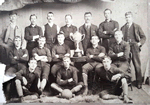 We're back in Scotland today starting off with this splendid photograph of the 1892-93 Arbroath team, winners of the Northern League and Forfarshire Cup. The photograph was sent to the Arbroath FC Website in January 2019 by Jamie Springford whose great grandfather, Joe Johnstone is seated on the front row with the ball between his feet.
We're back in Scotland today starting off with this splendid photograph of the 1892-93 Arbroath team, winners of the Northern League and Forfarshire Cup. The photograph was sent to the Arbroath FC Website in January 2019 by Jamie Springford whose great grandfather, Joe Johnstone is seated on the front row with the ball between his feet.
(Photo credit: Jamie Springford)
Thanks to research by Stewart Mathers I have been able to flesh out the history of Northern a bit more. The club spent just one season, 1893-94, in the Scottish Football League and went out of business in 1896.
Dundee United (November 1974-76 shorts corrected), Kilmarnock (1973-77 Admiral logo added), Airdrieonians (1974-77 crest and logos removed - these appeared only in the 1974-75 Scottish Cup final), Partick Thistle (1974-75 shorts corrected), Motherwell (1974-76 shorts stripe removed), Falkirk (1973-74 crest added), Aberdeen (1972-75, 1975-76 collar & logos adjusted), Clyde (changes to strip now confirmed to have occurred January 1976), Montrose (1975-76 added), St Johnstone (1975-76 added).
15 November - Miscellaneous
 Sheffield United have worn black shorts since the beginning of the 20th century, at least until 1967-68, when they adopted white shorts and socks. Tony Sealey has discovered that this strip first appeared in September 1966 when, at the request of the referee, United switched to white shorts and socks for a midweek game under floodlights against Tottenham Hotspur. The Blades won and continued to wear white shorts at home until they were beaten by Birmingham City in the League Cup in December, after which they reverted to their familiar black shorts for the rest of the season.
Sheffield United have worn black shorts since the beginning of the 20th century, at least until 1967-68, when they adopted white shorts and socks. Tony Sealey has discovered that this strip first appeared in September 1966 when, at the request of the referee, United switched to white shorts and socks for a midweek game under floodlights against Tottenham Hotspur. The Blades won and continued to wear white shorts at home until they were beaten by Birmingham City in the League Cup in December, after which they reverted to their familiar black shorts for the rest of the season.
(Photo credit: Football League Review 21 October 1967)
Tony has also tracked down some photographs that help show how Tottenham Hotspur's famous cockerel crest evolved between 1921, when it was introduced, and 1930.
Cheltenham Town (2021-22 shorts updated).
1 November - Scotland again
Third Lanark (954-55, 1962-63 added), East Fife (1972-73 variant kits added), Dundee (1972-73 corrected), Dundee United (1972-73 & 1973-74 variant kits added), Greenock Morton (1972-74 collar adjusted), Dumbarton (October 1973 kit added), Falkirk (1973-74 added), Ayr United (1973-74 added), Clyde (1973-74 added), Rangers (1973-74 change socks corrected).
27 October - More Scottish Updates
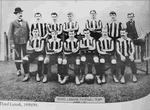 Aberdeen (April 1971-1972 added), Greenock Morton (1970-72 numeral added to shorts), Berwick Rangers (1967-1973 shirts revised), Hibernian (1970-71 dates when socks were changed now confirmed, 1971-72 kits added), Heart of Midlothian (1971-72 added), Partick Thistle (1971-72 kit confirmed), St Johnstone (1971-72 kits confirmed), Clydebank (1971-72 kits confirmed), Ayr United (1971-72 added), Third Lanark (1898-1900 corrected), 1948-49 added, 1963-65 & 1965-66 now shown with short sleeves and correct shirt trim).
Aberdeen (April 1971-1972 added), Greenock Morton (1970-72 numeral added to shorts), Berwick Rangers (1967-1973 shirts revised), Hibernian (1970-71 dates when socks were changed now confirmed, 1971-72 kits added), Heart of Midlothian (1971-72 added), Partick Thistle (1971-72 kit confirmed), St Johnstone (1971-72 kits confirmed), Clydebank (1971-72 kits confirmed), Ayr United (1971-72 added), Third Lanark (1898-1900 corrected), 1948-49 added, 1963-65 & 1965-66 now shown with short sleeves and correct shirt trim).
The photograph is of the Third Lanark team of 1898-99, wearing what were for the period, unusually broad stripes. My thanks to Ian McConnel and Seamus Ferry for today's material.
(Photo credit: Third Lanark: Images of Sport - Bob Laird 1999)
22 October
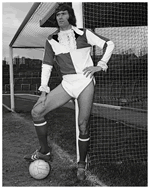 1967 was a momentous year for arts and culture in the UK. The Beatles released Sgt Pepper's Lonely Hearts Club Band and, along with artists such as Jimi Hendrix, Cream, Pink Floyd and Jethro Tull, were redefining what popular music could be. "Swinging London" and the boutiques of Carnaby Street were revolutionising youth fashion. Men sprouted long hair, sideburns and droopy moustaches while girls jumped in and out of MkII Austin Minis wearing miniskirts and Vidal Sassoon hair cuts. A wave of working-class actors like Michael Caine, Tom Courtney, Richard Harris and Albert Finney were turning the world of film and theatre on its head.
1967 was a momentous year for arts and culture in the UK. The Beatles released Sgt Pepper's Lonely Hearts Club Band and, along with artists such as Jimi Hendrix, Cream, Pink Floyd and Jethro Tull, were redefining what popular music could be. "Swinging London" and the boutiques of Carnaby Street were revolutionising youth fashion. Men sprouted long hair, sideburns and droopy moustaches while girls jumped in and out of MkII Austin Minis wearing miniskirts and Vidal Sassoon hair cuts. A wave of working-class actors like Michael Caine, Tom Courtney, Richard Harris and Albert Finney were turning the world of film and theatre on its head.
And so to football and this vision of the "kit of the future" modelled by Arsenal centre-half, Peter Simpson at Highbury in August 1967. My thanks to Willie Kay for this little gem.
(Photo credit:@HistoricPhotographs)
15 October - Scottish Updates
We have some more contributions from Ian McConnel: Dundee (August 1968 added), Greenock Morton (1968-69 kits updated, 1969-70 added), Clyde (1968-69 socks corrected, 1969-70 added), Aberdeen (1968-69 added), Heart of Midlothian (March-May 1969 added, 1969-70 updated with three kits), Arbroath (1968-69 added), Falkirk (Jan-March 1969, 1969-70 alternate added), St Johnstone (1969-70 corrected), Raith Rovers 1969-70 added), Montrose (1969-70 added), Kilmarnock (1969-70 collar corrected).
14 October
 We have known for some time that in the first decade of the twentieth century Aston Villa sometimes wore red shirts instead of their thick, woollen claret and blue sweaters, which woud have been unbearable in warm weather. Jon Farrelly has come across some very rare photographs of these alternative tops in action against Everton in October 1901. A unique feature of these these shirts is that they had short sleeves, unheard of at the time. We also see Everton in their new royal blue shirts, which replaced the Cambridge Blue tops worn since 1892. These appear paler than Villa's tops due to the effect of the orthographic film stock widely used at the time.
We have known for some time that in the first decade of the twentieth century Aston Villa sometimes wore red shirts instead of their thick, woollen claret and blue sweaters, which woud have been unbearable in warm weather. Jon Farrelly has come across some very rare photographs of these alternative tops in action against Everton in October 1901. A unique feature of these these shirts is that they had short sleeves, unheard of at the time. We also see Everton in their new royal blue shirts, which replaced the Cambridge Blue tops worn since 1892. These appear paler than Villa's tops due to the effect of the orthographic film stock widely used at the time.
(Photo credit: The Illustrated Sporting & Dramatic News 3 October 1901.)
11 October: Bits 'n'Bobs
Tottenham Hotspur (1919-21 change shirt corrected, date for first appearance of the chocolate and gold shirts revised), Liverpool (2021-22 shirt sponsor updated), Wimbledon (unsponsored shirts reintroduced November 1980).
Aberdeen (1966-67 corrected), Falkirk (1966-67 strips revised), Elgin City (1966-67 warm weather kit added), Stirling Albion (1967-68 added), Greenock Morton (1967-68 strips updated), Dundee United (1967-68 warm weather kit added).
30 September - Bobs 'n' Bits
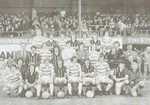 Inverness Thistle (1976 -77 left, 1991-92 added). Gillingham (1991 crest revised, August 1995 sponsorship corrected), Clapham Rovers (1873 socks confirmed), Charlton Athletic (1932-33, 1933-34 added. We also now have evidence that the"ace of clubs" crest dates from 1932 and not 1935). Barnet (1924-25 added).
Inverness Thistle (1976 -77 left, 1991-92 added). Gillingham (1991 crest revised, August 1995 sponsorship corrected), Clapham Rovers (1873 socks confirmed), Charlton Athletic (1932-33, 1933-34 added. We also now have evidence that the"ace of clubs" crest dates from 1932 and not 1935). Barnet (1924-25 added).
 The rather poor photograph on the right shows The Bees in vertical stripes playing Sutton United in the Athenian League during 1924-25.
The rather poor photograph on the right shows The Bees in vertical stripes playing Sutton United in the Athenian League during 1924-25.
(Photo Credit: Caley Thistle Online)
29 September - Watford Update
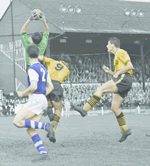 Geoff Allen, an expert on the history of Watford's kits, has been kind enough to document the team's kits from 1959, when they switched from blue and white to gold and black, up until 1978. This includes several previously unrecorded strips and confirms the period that gold was dropped in favour of yellow.
Geoff Allen, an expert on the history of Watford's kits, has been kind enough to document the team's kits from 1959, when they switched from blue and white to gold and black, up until 1978. This includes several previously unrecorded strips and confirms the period that gold was dropped in favour of yellow.
The colourised photograph is from the Watford Observer and iillustrates an interview with Geoff on the topic.
28 September - Bits 'n' Bobs
 Thanks to Lee Capeling I've been able to add important detailing to the Maidstone United 1988-89 kit. Pictured on the left is the Stones team wearing this kit after winning promotion to the Football League. Barnet wore the same Umbro top at the time.
Thanks to Lee Capeling I've been able to add important detailing to the Maidstone United 1988-89 kit. Pictured on the left is the Stones team wearing this kit after winning promotion to the Football League. Barnet wore the same Umbro top at the time.
(Photo credit: The Non-League Paper)
Bolton Wanderers did not have the Umbro double-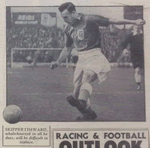 diamond trim on their shorts between 1977 and 1982 and this has now been removed. I have also added the kit worn by Watford from August 1973 until February 1974.
diamond trim on their shorts between 1977 and 1982 and this has now been removed. I have also added the kit worn by Watford from August 1973 until February 1974.
As any fule kno, England dropped their blue change 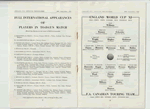 shirts in favour of red after their humiliating defeat against the United States in the 1950 World Cup. Tony Sealey has discovered that the first time the new tops appeared was in the Charity Shield on 20 September 1950 in a match between the England World Cup team and the FA Canadian Touring side.
shirts in favour of red after their humiliating defeat against the United States in the 1950 World Cup. Tony Sealey has discovered that the first time the new tops appeared was in the Charity Shield on 20 September 1950 in a match between the England World Cup team and the FA Canadian Touring side.
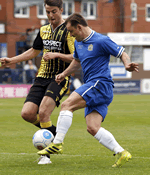 To mark the 50th anniversary of winning the old Fourth Division title for the first time, Stockport County wore a special strip against Gloucester City on the 29 April 2017. This was an exact replica of the outfit worn during 1966-67 and I can remember the original vividly. County came to play my team, Southport, on 11 February 1967, my birthday. We were chasing Stockport for the title and hopes went through the roof after Billy Bingham's Golden Boys handed the visitors a 4-0 spanking. Stockport, however, proved more consistent in the run in to the end of the season but Southport did claim the runners-up spot and their first ever promotion.
To mark the 50th anniversary of winning the old Fourth Division title for the first time, Stockport County wore a special strip against Gloucester City on the 29 April 2017. This was an exact replica of the outfit worn during 1966-67 and I can remember the original vividly. County came to play my team, Southport, on 11 February 1967, my birthday. We were chasing Stockport for the title and hopes went through the roof after Billy Bingham's Golden Boys handed the visitors a 4-0 spanking. Stockport, however, proved more consistent in the run in to the end of the season but Southport did claim the runners-up spot and their first ever promotion.
27 September
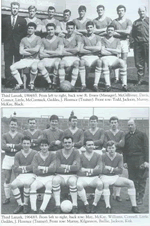 With the 2021-22 kits out of the way I'm going to work through the HFK inbox starting with Ian McConnel's submission on Scottish clubs from the mid 1960s.
With the 2021-22 kits out of the way I'm going to work through the HFK inbox starting with Ian McConnel's submission on Scottish clubs from the mid 1960s.
Airdrieonians (1964-65 added), St Mirren (1946-65 cold weather kit added), Aberdeen (1964-65 crest added, 1965-66 three kits added), Third Lanark (1964-65 detailing corrected), Falkirk (1964-66 added), Clyde (1963-66 shirt cuffs corrected), Dundee (1965-68 crest corrected), Greenock Morton (1965-66 three strips added), St Mirren (1964-66 cold weather kit added),
The photographs shows the Third Lanark team from 1964-65 wearing both their short sleeved warm weather shirts and the long-sleeved winter versions.
23 September
 I have now completed the 2021-22 updates for Scottish clubs (including former members). I'm also pleased to announce that Kelty Hearts, who won promotion to Scottish League Two via the play-offs in May, have their own section on HFK.
I have now completed the 2021-22 updates for Scottish clubs (including former members). I'm also pleased to announce that Kelty Hearts, who won promotion to Scottish League Two via the play-offs in May, have their own section on HFK.
(Photo credit: Dunfermline Press)
8 September
 I have been lucky enough to track down an original copy of Sutton United's 75th Anniversary Souvenir Book published in 1973. Although unread, due to its age the glue along the spine had perished and all the pages became detached as I worked my way through it! Nevertheless this has proved to be a treasure trove that has allowed me to flesh out the club's kit history from their formation to the early 1970s. The origin of the their distinctive traditional colours is revealed
I have been lucky enough to track down an original copy of Sutton United's 75th Anniversary Souvenir Book published in 1973. Although unread, due to its age the glue along the spine had perished and all the pages became detached as I worked my way through it! Nevertheless this has proved to be a treasure trove that has allowed me to flesh out the club's kit history from their formation to the early 1970s. The origin of the their distinctive traditional colours is revealed  and into the bargain, we have extremely rare photographs of the two teams that merged to form the modern club. Above left is Sutton St Barnabas wearing the chocolate and amber shirts which would be inherited by the merged club. On the right is Sutton Guild Rovers. The colour of their plain shirts is not recorded but I believe these were probably red. Both pictures date from 1897-98, immediately before they amalgamated.
and into the bargain, we have extremely rare photographs of the two teams that merged to form the modern club. Above left is Sutton St Barnabas wearing the chocolate and amber shirts which would be inherited by the merged club. On the right is Sutton Guild Rovers. The colour of their plain shirts is not recorded but I believe these were probably red. Both pictures date from 1897-98, immediately before they amalgamated.
(Photo Credit: Sutton United Football Club 1898-1973)
3 September
Our old friend and Burnleyite Ralph Pomeroy has been in touch about the picture of Sutton United posted here on 28 August. It turns out that the team is not the Sutton United that is based in south-west London but a side from the village of Sutton-in-Craven in North Yorkshire. Oops!
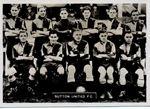 Furthermore, it turns out that the photograph of the 1903 team that I placed on the club page is not of the London team either but another village side, this time from Sutton-under-Brailes in Warwickshire.
Furthermore, it turns out that the photograph of the 1903 team that I placed on the club page is not of the London team either but another village side, this time from Sutton-under-Brailes in Warwickshire.
How there could be three teams with the same name is a bit odd. Presumably the Yorkshire and Warwickshire clubs were only affiliated to their local county FAs. Had they been affiliated to the national FA they would have had to change their names.
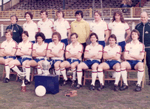 The image above left is definitely of the side from the Outer London Borough of Sutton & Cheam and was taken in 1936.
The image above left is definitely of the side from the Outer London Borough of Sutton & Cheam and was taken in 1936.
Now here's a knotty little pub-quiz teaser. Can you name the team in the photograph on the right? Clue: it's not what it looks like. In fact, if you've been paying attention you'll probably have worked out that it is in fact...Sutton United. In 1979 they were chosen by the FA to play in the Alitalia Challenge Cup (previously the Anglo-Italian Cup but now a competition for semi-professional teams). Unexpectedly they won the tournament and in the final they wore a set of England strips presented to them by the FA
(1979 Photo Credit: The Non-League Football Paper 2 September 2012)
1 September
I've now finishing posting the remaining EFL kit graphics and those of former members.
I'll start work on the Scottish clubs shortly.
31 August
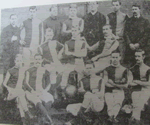 By way of a slight diversion, I've today made some new additions to the Eminent Victorians Midlands section, Derby St Lukes (1883-84 team pictured left). St Lukes were founder members of the Derbyshire FA and took their name from St Luke's Church. Both the president and vice-president (back row centre) were clergymen so we can assume the club was one of many founded by church ministers.
By way of a slight diversion, I've today made some new additions to the Eminent Victorians Midlands section, Derby St Lukes (1883-84 team pictured left). St Lukes were founder members of the Derbyshire FA and took their name from St Luke's Church. Both the president and vice-president (back row centre) were clergymen so we can assume the club was one of many founded by church ministers.
Ockbrook School was one of the oldest independent (ie private) schools in Derbyshire (founded 1799) and formed the first association football team in the county in 1867. The school permanently closed in July of this year due to financial losses exacerbated by the Covid pandemic.
Trent College (an independent school located in Long Eaton) fielded a strong football in the 1870s that went unbeaten for three years. Derby Grammar School were early exponents of the passing game in England and played regularly against the top sides in the Midlands. In 1874 they were narrowly beaten 1-0 by Oxford University, the FA Cup holders.
(Photo credit: The Sweetest Rose: 150 Years of Yorkshire County Cricket Club-David Warner 2012).
Now to crack on with the last EFL kit graphics...
28 August
 We welcome Sutton United, whose distinctive chocolate and amber colours now grace the HFK archive. As one might expect, information about their early kits is sketchy and I hope that the HFK Elves will get busy to help fill in the gaps. This photograph shows the 1914 team in the striped tops that they had worn since the club's formation in 1898. (NB See update 3 September.)
We welcome Sutton United, whose distinctive chocolate and amber colours now grace the HFK archive. As one might expect, information about their early kits is sketchy and I hope that the HFK Elves will get busy to help fill in the gaps. This photograph shows the 1914 team in the striped tops that they had worn since the club's formation in 1898. (NB See update 3 September.)
(Photo credit: Craven Herald & Pioneer)
18 August - 2021-22 Update
I've resumed updating the site with the new League One kits following a break caused by a brief illness.
5 August - 2021-22 Update
The missing Crystal Palace strip and all the Championship kits are now on the site. Next up will be League One.
30 July
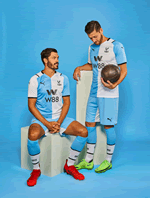 All the new Premier League kits are now on the site with the exception of Crystal Palace who have yet to reveal their new first kit, the cheeky little minxes. Palace have, however, released a new "special edition" third kit that they claim is based on the colours worn by the team in 1861. HFK frequent flyers will know that their claim to be the oldest football team in the world has been comprehensively demolished (they were formed in 1905) and the notion that the original Victorian team played in light blue and white halves is based on no evidence at all. It is, however, astonishing how people are prepared to ignore the evidence if it does not suit their preformed ideas.
All the new Premier League kits are now on the site with the exception of Crystal Palace who have yet to reveal their new first kit, the cheeky little minxes. Palace have, however, released a new "special edition" third kit that they claim is based on the colours worn by the team in 1861. HFK frequent flyers will know that their claim to be the oldest football team in the world has been comprehensively demolished (they were formed in 1905) and the notion that the original Victorian team played in light blue and white halves is based on no evidence at all. It is, however, astonishing how people are prepared to ignore the evidence if it does not suit their preformed ideas.
I'll tackle the Championship clubs next week.
(Photo credit: Greg Colman/cpfc.co.uk London News Online)
29 July
2021-22 additions: Leeds United, Leicester City, Liverpool, Manchester City, Manchester United.
27 July
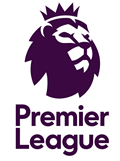 All the remaining broken affliate links have now been repaired apart from a few in the more obscure parts of the site. With that out of the way I can turn my attention to the new 2021-22 club kits, starting with the Premier League.
All the remaining broken affliate links have now been repaired apart from a few in the more obscure parts of the site. With that out of the way I can turn my attention to the new 2021-22 club kits, starting with the Premier League.
Added so far are Arsenal, Aston Villa, Brentford, Brighton, Burnley, Chelsea and Everton. More to follow later this week.
14 July
![]() I have now completed the overhaul of broken UKSoccershop links on all the English (and Welsh!) club pages as well as the FA Cup finalists section. I'll tackle the remaining Scottish clubs over the next few days and then I'll fix the links to the Vintage Football Shirts online store. In the process I've removed some redundant links but also added quite a few new ones for shirts that were out of stock but are now once again available. If you are a colector or just like football shirts you may find it rewarding to visit your favourite club pages on HFK to see what is available.
I have now completed the overhaul of broken UKSoccershop links on all the English (and Welsh!) club pages as well as the FA Cup finalists section. I'll tackle the remaining Scottish clubs over the next few days and then I'll fix the links to the Vintage Football Shirts online store. In the process I've removed some redundant links but also added quite a few new ones for shirts that were out of stock but are now once again available. If you are a colector or just like football shirts you may find it rewarding to visit your favourite club pages on HFK to see what is available.
12 July
 Last night's result at Wembley was bitterly disappointing but the racist backlash directed against some of the players through social media is an absolute disgrace as is the racially aggravated damage to a mural of Marcus Rashford in Manchester. We can be proud of Gareth Southgate and his squad not only for the wonderful football they have played during the tournament but also for the principled stand they have taken collectively to celebrate equality and diversity. It is all very well for the Prime Minister and Home Secretary to condemn the abuse but only a few weeks ago they were both expressing support for those supporters who booed the England players when they took the knee in a gesture of solidarity against racism.
Last night's result at Wembley was bitterly disappointing but the racist backlash directed against some of the players through social media is an absolute disgrace as is the racially aggravated damage to a mural of Marcus Rashford in Manchester. We can be proud of Gareth Southgate and his squad not only for the wonderful football they have played during the tournament but also for the principled stand they have taken collectively to celebrate equality and diversity. It is all very well for the Prime Minister and Home Secretary to condemn the abuse but only a few weeks ago they were both expressing support for those supporters who booed the England players when they took the knee in a gesture of solidarity against racism.
(Photo credit: Tom Jenkins/The Guardian)
![]() The UKSoccershop affiliate links on the Leeds United, Leicester City, Leyton Orient, Lincoln City, Liverpool, Luton Town, Macclesfield Town, Maidstone United, Manchester City, Manchester United, Mansfield Town, Middlesbrough, Millwall and Newcastle United pages have now been repaired.
The UKSoccershop affiliate links on the Leeds United, Leicester City, Leyton Orient, Lincoln City, Liverpool, Luton Town, Macclesfield Town, Maidstone United, Manchester City, Manchester United, Mansfield Town, Middlesbrough, Millwall and Newcastle United pages have now been repaired.
2 July
![]() The UKSoccershop affiliate links on the Gateshead, Gillingham, Grimsby Town, Halifax Town, Hartlepool United, Hereford United, Huddersfield Town, Hull City, Ipswich Town, Leeds City and Leeds United pages are now working.
The UKSoccershop affiliate links on the Gateshead, Gillingham, Grimsby Town, Halifax Town, Hartlepool United, Hereford United, Huddersfield Town, Hull City, Ipswich Town, Leeds City and Leeds United pages are now working.
1 July
![]() The affiliate links for UKSoccershop have been been repaired for Crystal Palace, Darlington, Everton, Exeter City and Fulham.
The affiliate links for UKSoccershop have been been repaired for Crystal Palace, Darlington, Everton, Exeter City and Fulham.
30 June
 Thank you Mr Southgate. Can we have three more like that please?
Thank you Mr Southgate. Can we have three more like that please?
Find every Euro 2020 kit from every match exclusively on HFK as well as the complete Euro and World Cup kit histories.
(Photo credit: AP, Frank Augstein. Pool)
![]() I'm afraid that the deep links to Vintage Football Shirts are currently broken. I understand that the company are putting their own Affiliate Marketing program in place and as soon as this is done I will update our links.
I'm afraid that the deep links to Vintage Football Shirts are currently broken. I understand that the company are putting their own Affiliate Marketing program in place and as soon as this is done I will update our links.
![]() Meanwhile I am continuing to repair the broken UKSoccershop links: English club pages from Accrington Stanley to Crystal Palace have now been repaired.
Meanwhile I am continuing to repair the broken UKSoccershop links: English club pages from Accrington Stanley to Crystal Palace have now been repaired.
Odds & Sods
Caledonian (Feb-May 1991 added, 1991-92 corrected), Southport (1977-78 corrected), Crewe Alexandra (1982-83 added). With some nifty detective work by John Taylor, we have been able to confirm that Mansfield Town first adopted long sleeved amber shirts with blue trim in 1961-62.  The short sleeved version shown on HFK was a warm weather variant worn 1961-63.
The short sleeved version shown on HFK was a warm weather variant worn 1961-63.
I find this photograph of the 1982-83 Crewe Aexandra team wearing their new but unremarkable Patrick strip oddly pleasing with all the players sporting perms placed together on one side.
26 June
I am currently restoring deep links to the UKSoccerShop store: all links on English club pages A-B are now working. Links to other retailers that are broken are being replaced or removed.
23 June
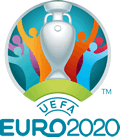 The Affiliate Links in the Euro 2020 section are now working once more.
The Affiliate Links in the Euro 2020 section are now working once more.
22 June - Watford Revisited
 In March of this year (see News & Updates 3 March below) I reported that an undated Queen's Park Rangers match programme described Watford's colours as "turquoise and white." The first known mention of this unusual colour was in the Northampton Chronicle & Echo (June 1927) and it crops up again in the 1934 Football Encyclopedia (a source I have found to be generally unreliable), a few match programmes where Watford were the visitors and in some items of memorabilia. Photographs from the period, such as the 1928-29 group shown above, are ambiguous given what we know about orthographic film stock.
In March of this year (see News & Updates 3 March below) I reported that an undated Queen's Park Rangers match programme described Watford's colours as "turquoise and white." The first known mention of this unusual colour was in the Northampton Chronicle & Echo (June 1927) and it crops up again in the 1934 Football Encyclopedia (a source I have found to be generally unreliable), a few match programmes where Watford were the visitors and in some items of memorabilia. Photographs from the period, such as the 1928-29 group shown above, are ambiguous given what we know about orthographic film stock.
I have now heard from Geoff Allen and Neil Dunham who have between them examined hundreds of press reports and over 150 official Watford match programmes and club handbooks. Not one of these mentions turquoise and the team's colours are consistently described as "royal blue and white."
This, in my opinion, settles the matter once and for all. What we seem to have here is a football myth that started with an inaccurate source and then got repeated by writers who were either too lazy or too pressed by their deadline to check their source (on what it must be said, was a trivial detail) until it became established as fact.
17 June
Stoke City (1965-66 warm weather kit added), Hereford United (1960-62 detailing added).
16 June
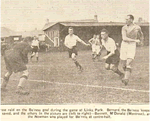 This photograph is of the match between Montrose (in white) and Bo'ness in 1932-33. Note how the turnover on the visitors' socks (which are red) appear darker than the blue leg, which suggests the image was taken using orthographic film stock. Due to a severe financial problems, Bo'ness were unable to raise the £50 match guarantee fees paid to visiting teams and were expelled from the Scottish Second Division later that season.
This photograph is of the match between Montrose (in white) and Bo'ness in 1932-33. Note how the turnover on the visitors' socks (which are red) appear darker than the blue leg, which suggests the image was taken using orthographic film stock. Due to a severe financial problems, Bo'ness were unable to raise the £50 match guarantee fees paid to visiting teams and were expelled from the Scottish Second Division later that season.
(Photo credit: Dundee Evening Telegraph 29 August 1932 retrieved by Alick Milne.)
Queen's Park Rangers (March-May 2021 added), Charlton Athletic (1980-81 shorts corrected), Mansfield Town (1956-57 added).
15 June
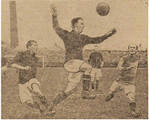 Our senior Scottish Elf, Alick Milne has been digging through his notebooks and sent me a lot of material on Motherwell's change kits, filling in much of the previously blank period from the formation of the club in 1886 and 1928. In addition he has uncovered previously unrecorded kits from the 1930s and 1950s. This image, from the Dundee Courier (7 October 1919) shows them wearing a reversed version of their amber yoked claret jerseys of the period.
Our senior Scottish Elf, Alick Milne has been digging through his notebooks and sent me a lot of material on Motherwell's change kits, filling in much of the previously blank period from the formation of the club in 1886 and 1928. In addition he has uncovered previously unrecorded kits from the 1930s and 1950s. This image, from the Dundee Courier (7 October 1919) shows them wearing a reversed version of their amber yoked claret jerseys of the period.
The Euro 2020 section is now being updated with match-by-match details.
10 June
 Last-minute kit changes and additions have been added to the Euro 2020 Section today.
Last-minute kit changes and additions have been added to the Euro 2020 Section today.
3 June
Just over a year ago I featured Palace at the Palace, in which the author, Peter Manning, attempted to prove that the original Crystal Palace football club, formed in 1861, and the modern one are one and the same. This led to the current club making a formal claim to be recognised as the oldest professional club in the world. This claim was comprehensively debunked by two leading football historians, Mark Metcalf and Clive Nicholson and is no longer taken seriously by anyone outside SE25.
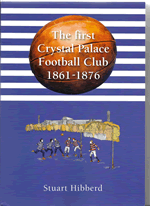 While this controversy was going on, Stuart Hibberd, a long-standing friend of HFK, was quietly getting on with his own research into the original Crystal Palace club. Years in the preparation, The First Crystal Palace Football Club 1861-1876 was finally published last month. The title is significant: Hibberd is a serious football historian whose research proves once and for all that there is no link between the original club and the modern one.
While this controversy was going on, Stuart Hibberd, a long-standing friend of HFK, was quietly getting on with his own research into the original Crystal Palace club. Years in the preparation, The First Crystal Palace Football Club 1861-1876 was finally published last month. The title is significant: Hibberd is a serious football historian whose research proves once and for all that there is no link between the original club and the modern one.
Hibberd also dispels the myth that the club was formed by workers at the Great Exhibition site. His detailed biographies of the original members shows they were well-to-do gentlemen of means who were highly influential in the creation of the FA and the instigation of the FA Cup. Lavishly illustrated throughout and impeccably researched, the book charts the formation, career and demise of the club, its members and their opponents and provides a brilliant insight into how the game developed in its earliest years.
The First Crystal Palace Football Club 1861-1876 is available from 1861football@gmail.com price £20+£3.50 postage & packing.
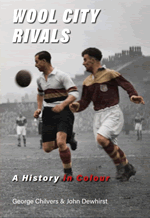 HFK frequent flyers may be familiar with the work of contributor George Chilvers who, as well as providing information about his beloved Wigan Athletic's kits, has a sideline in colourising old black and white photographs, several of which I have featured here over the years. George has teamed up with leading Bradford football historian and HFK contributor, John Dewhirst to produce the latest in the History Revisited series of books about the origins and history of professional football in Bradford.
HFK frequent flyers may be familiar with the work of contributor George Chilvers who, as well as providing information about his beloved Wigan Athletic's kits, has a sideline in colourising old black and white photographs, several of which I have featured here over the years. George has teamed up with leading Bradford football historian and HFK contributor, John Dewhirst to produce the latest in the History Revisited series of books about the origins and history of professional football in Bradford.
Wool City Rivals presents us with hundreds of photographs charting the history of Bradford City and Bradford (Park Avenue) from their formation up to the early Seventies, all painstakingly colourised by George and accompanied by informative commentary from John. The result is stunning. The colourised images bring what would otherwise be bog standard photographs to life. Unlike the colourised images produced by commercial software that focus on getting colour onto the subject regardless of whether or not it looks right, the images here have been prepared in meticulous detail, even to the extent of individually treating distant spectators.
For kit anoraks there are some special treats in store such as the revelation that Bradford (Park Avenue)'s earliest jerseys were not hooped as has been long believed, and that Bradford City's yoked tops, revived in the early 50s, included a bantam crest.
I cannot recommend this volume highly enough - available from bantamspast price £33.50 including postage & packing.
Note about Affiliate Links
It has come to my attention that the deep links to UKSoccerShop and Kitbag are currently broken. This is due to the parent companies switching to new Affiliate Marketing partners without letting me know. I will be restoring these links as soon as possible but this is an enormous task as the code for each link needs to be rewritten manually and there are hundreds to get through. I shall prioritise Euro 2020 followed by the Premier League, EFL and SPFL in that order. Updates will be posted here to keep visitors informed.
Links to other online stores are not affected.
18 May
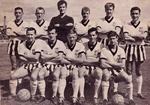 Today we have more Scottish updates from Ian McConnel. The ludicrous striped shorts worn by St Mirren at the start of the 1962-63 season (left) did not long survive the scorn of players and fans alike and had disappeared by September 1962.
Today we have more Scottish updates from Ian McConnel. The ludicrous striped shorts worn by St Mirren at the start of the 1962-63 season (left) did not long survive the scorn of players and fans alike and had disappeared by September 1962.
Dundee United (August 1962 added), Dundee (September 1962 added), Greenock Morton (detailing on shorts and socks corrected), Motherwell (1962-63 socks corrected), Clyde (1962-63 added), Falkirk (November 1962 & March 1963 added, 1963-64 socks corrected), Queen of the South (1961-64 cold weather kit added), Ayr United (December 1962-1963 added), Aberdeen (1963-64 detailing corrected), Airdrieonians (Feb-May 1964 added), Hibernian (date of switch from Continental shirts to crew necks confirmed), St Mirren (Jan-May 1964 added).
11 May
 Regular contributor Michael Gluck has unearthed this photograph of the 1968-69 Crawley Town team wearing the kind of absolutely plain strip that was popular at the time.
Regular contributor Michael Gluck has unearthed this photograph of the 1968-69 Crawley Town team wearing the kind of absolutely plain strip that was popular at the time.
(Photo Credit: The Argus)
Raith Rovers (2011-12, 2012-13 socks corrected), Burton Albion (1975-76 added), Motherwell (2012-13 3rd, 2020-21 2nd correct Pantone shade applied).
 This photograph, supplied by Gary Drew, who edits the Southall FC match programme, shows his team scoring against Barnet in April 1954. Points of interest are that Barnet are in vertical stripes rather than the broad hoops that were more familiar at the time, and they are wearing the crest designed by their chairman, Sidney Robert Price.
This photograph, supplied by Gary Drew, who edits the Southall FC match programme, shows his team scoring against Barnet in April 1954. Points of interest are that Barnet are in vertical stripes rather than the broad hoops that were more familiar at the time, and they are wearing the crest designed by their chairman, Sidney Robert Price.
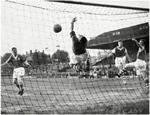 Finally for today, Geoff Allen has provided photographic evidence of a number variations in Watford's strips between 1946 and 1959. These are mainly changes to their socks but this photograph shows the team in blue shirts with white sleeves, a style adopted for the last two months of 1958-59. The following season they wore gold shirts and black shorts for the first time.
Finally for today, Geoff Allen has provided photographic evidence of a number variations in Watford's strips between 1946 and 1959. These are mainly changes to their socks but this photograph shows the team in blue shirts with white sleeves, a style adopted for the last two months of 1958-59. The following season they wore gold shirts and black shorts for the first time.
23 April
 For the last couple of weeks I have been sequestered in the deepest cellars of HFK Towers preparing the new Euro 2020 section. I'm pleased to announce that the Index Page is now complete with only the kits to be worn by North Macedonia to be announced.
For the last couple of weeks I have been sequestered in the deepest cellars of HFK Towers preparing the new Euro 2020 section. I'm pleased to announce that the Index Page is now complete with only the kits to be worn by North Macedonia to be announced.
UEFA confirmed the final list of venues earlier today and in due course I shall add the fixtures to the site so that when June rolls around I'll be able to create the usual match-by-match record.
Enjoy.
8 April
 I have tweaked a number of early Motherwell kit graphics: (1913-24, 1924-28, 1927-28 socks corrected, 1959-60 arm bands added). The photograph was taken in May 1927 when the team, which had finished as runners-up in the Scottish League, were invited to Spain to compete in a post season tournament. After beating Swansea Town, the Scottish side beat Real Madrid in the final and were awarded an unofficial version of the Copa del Rey trophy, donated by King Alfonso XIII.
I have tweaked a number of early Motherwell kit graphics: (1913-24, 1924-28, 1927-28 socks corrected, 1959-60 arm bands added). The photograph was taken in May 1927 when the team, which had finished as runners-up in the Scottish League, were invited to Spain to compete in a post season tournament. After beating Swansea Town, the Scottish side beat Real Madrid in the final and were awarded an unofficial version of the Copa del Rey trophy, donated by King Alfonso XIII.
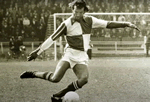 (Photo credit: Motherwell FC)
(Photo credit: Motherwell FC)
In April 1976 Bristol Rovers turned out in a new Admiral strip for a couple of matches. For reasons unknown, when the 1976-77 season started, Rovers were back in their unbranded tops with crew necks.
(Photo credit: Bristol Rovers Memorabilia)
Northampton Town (1901-02 added), West Bromwich Albion (1932-33 added), Ayr United (1968-69 added).
31 March
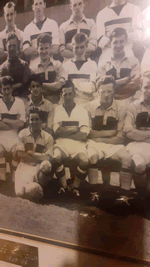 When I added the white Motherwell "floodlights kits" for 1958-62, I stated that these had short sleeves, based on the photograph posted on 26 March below. I've now received this photograph from Matt Johnstone showing detail from the much larger version that hangs in Fir Park. This shows definitively that the players are wearing long sleeved shirts rolled up to the elbow, thus hiding the armbands. Helpfully, the player at the centre of the picture has his sleeves rolled down, revealing the hidden detail.
When I added the white Motherwell "floodlights kits" for 1958-62, I stated that these had short sleeves, based on the photograph posted on 26 March below. I've now received this photograph from Matt Johnstone showing detail from the much larger version that hangs in Fir Park. This shows definitively that the players are wearing long sleeved shirts rolled up to the elbow, thus hiding the armbands. Helpfully, the player at the centre of the picture has his sleeves rolled down, revealing the hidden detail.
Also added today are Motherwell's 2002-03 third kit and 2009-10 change.
26 March
I've completed the new Motherwell Change Kit Section, which is sponsored by Motherwell FC. I am grateful to Stuart Graham, the club historian, Matt Johnstone, our old chum Willie Kay and club officials who took the trouble to compile and send to me the photographs from which I was able to create the graphics.
 This squad photograph from 1958-59 reflects common practice in Scotland at the time of having the first team decked out in the first choice kit while the reserves wear the change strip. They are modelling two new strips and for the first time they have a white change kit. Known as the "floodlights kit," this did service in several home games against European opposition under the new Fir Park floodlights. The two-tone chest band has been revived several times, most notably in the 2019-20.
This squad photograph from 1958-59 reflects common practice in Scotland at the time of having the first team decked out in the first choice kit while the reserves wear the change strip. They are modelling two new strips and for the first time they have a white change kit. Known as the "floodlights kit," this did service in several home games against European opposition under the new Fir Park floodlights. The two-tone chest band has been revived several times, most notably in the 2019-20.
There remain some gaps in the record and no information has so far come to light covering the first 40-odd years of the club's existence. I hope the HFK Elves will be able to fill in some of the gaps.
(Photo Credit: Motherwel FC)
23 March
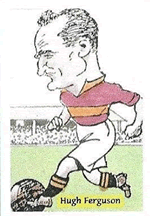 I am very pleased to announce that, in the first agreement of its kind, I am today opening a brand new section covering Motherwell's Change Kits. This section is being sponsored by Motherwell FC and is launched today as a work in progress. Once I have posted all of the material that I have in hand, I shall invite the HFK Elves to fill in the remaining gaps.
I am very pleased to announce that, in the first agreement of its kind, I am today opening a brand new section covering Motherwell's Change Kits. This section is being sponsored by Motherwell FC and is launched today as a work in progress. Once I have posted all of the material that I have in hand, I shall invite the HFK Elves to fill in the remaining gaps.
Illustrated here is the traditional change strip worn between 1928 and 1958. This was needed so rarely that photographs of it in action are exteremly hard to come by.
(Photo Credit: Matt Johnstone)
18 March
We have more Scottish club updates from Ian McConnel today. St Mirren (1960-61, Jan-May 1962 added), Airdrieonians (January 1961, January 1962 added), Dunfermline Athletic (1960-61, 1961-62 (two kits) added), Third Lanark (1960-62 cold weather kit added), Raith Rovers 1961-62 added, Dundee United (1961-62 cold weather kit added), Aberdeen (1961-62 (two kits) added.
17 March
 This photograph of Queens Park Rangers from 1927-28 reveals the unusual arrangement of their sleeves.
This photograph of Queens Park Rangers from 1927-28 reveals the unusual arrangement of their sleeves.
Southampton (1927-28, 1928-30, 1930-31, 1934-38, 1948-49 alternate added, 1945-46 corrected), Reading (1956-57 corrected, 1975-76 added).
16 March
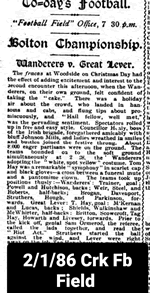 This cutting from Cricket & Football Field (2 January 1886), submitted by Andy Boocock, caught my attention. It describes a match between Bolton Wanderers and local rivals, Great Lever and mentions that Bolton were wearing "white, spot yellow jerseys." Since we know that Wanderers were in striped shirts at the start of the season my first reaction was that this was a change strip but as Great Lever wore dark blue shirts and knickers, there would have been no need to change. Since we recently were able to confirm that the team had worn white jerseys with "red spots the size of threepenny bits" in 1884, it seems possible that they had bought another set of spotty tops part way through the 1885-86 season. Bolton was, after all, replete with cotton mills capable of turning out all sorts of patterned fabric.
This cutting from Cricket & Football Field (2 January 1886), submitted by Andy Boocock, caught my attention. It describes a match between Bolton Wanderers and local rivals, Great Lever and mentions that Bolton were wearing "white, spot yellow jerseys." Since we know that Wanderers were in striped shirts at the start of the season my first reaction was that this was a change strip but as Great Lever wore dark blue shirts and knickers, there would have been no need to change. Since we recently were able to confirm that the team had worn white jerseys with "red spots the size of threepenny bits" in 1884, it seems possible that they had bought another set of spotty tops part way through the 1885-86 season. Bolton was, after all, replete with cotton mills capable of turning out all sorts of patterned fabric.
In the course of researching this item, I came across an unrecorded Bolton Wanderers strip from 1887-88 which I've added.
Berwick Rangers 1983-84 added.
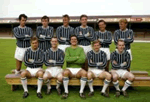 Last March I revised Southend United's kit graphics 1961-1968 to show them in navy blue and white. This was based in part on this photograph from 1964-65. However, old colour photographs can be misleading and I do remember watching the team play at Southport in 1966-67 wearing what seemed to be rather scruffy, washed out miid-blue shirts but memory can also be unreliable. However, Jack Bond has now resolved the issue by confirming that the team played in royal-blue and white during this period. It was not until 1968-69 that they switched to navy blue and attracted the dispproval of the Football League.
Last March I revised Southend United's kit graphics 1961-1968 to show them in navy blue and white. This was based in part on this photograph from 1964-65. However, old colour photographs can be misleading and I do remember watching the team play at Southport in 1966-67 wearing what seemed to be rather scruffy, washed out miid-blue shirts but memory can also be unreliable. However, Jack Bond has now resolved the issue by confirming that the team played in royal-blue and white during this period. It was not until 1968-69 that they switched to navy blue and attracted the dispproval of the Football League.
15 March
Salford City won their first senior competition on Saturday when they beat Portsmouth on penalties in the final of the EFL Trophy, a match postponed since last April due to the Covid-19 pandemic. The cup, which now revels in the dignified title of The Papa John's Trophy was handed back immediately because Sunderland and Tranmere Rovers met at Wembley the following day to 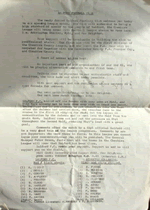 contest the 2021 final. This seems a good moment to share these images of the official match programme from club's first game in the Cheshire County League as Salford FC, submitted by Ralph Pomeroy.
contest the 2021 final. This seems a good moment to share these images of the official match programme from club's first game in the Cheshire County League as Salford FC, submitted by Ralph Pomeroy.
(Photo credit Steve Hardy: Football Grounds in Focus.)
I am grateful to John Disson, whose family have supported Queen's Park Rangers since the 1890s, for sending me an article he wrote for the club to mark 50 years since the reintroduction of the teams signature 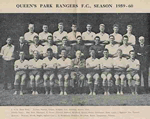 broad hoops in 1960. This is a year later than I had previously thought and is confirmed by this photograph showing the 1959-60 team wearing the nondescript white jerseys introduced in 1953.
broad hoops in 1960. This is a year later than I had previously thought and is confirmed by this photograph showing the 1959-60 team wearing the nondescript white jerseys introduced in 1953.
(Photo credit: Official QPR match programme September 14 1959.)
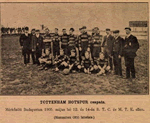 Tony Sealey and Bob Goodwin recently found this photograph of the Tottenham Hotspur side that toured Austria-Hungary in May 1905. Although this appeared in a Hungarian newspaper prior to Spurs' matches against Budapesti Torna Club and MTK Budapest on 12th and 14th May, Bob has identified the line-up as the one that met a Viennese Select XI on 4th May. I assume that they borrowed the hooped jerseys because of a colour clash.
Tony Sealey and Bob Goodwin recently found this photograph of the Tottenham Hotspur side that toured Austria-Hungary in May 1905. Although this appeared in a Hungarian newspaper prior to Spurs' matches against Budapesti Torna Club and MTK Budapest on 12th and 14th May, Bob has identified the line-up as the one that met a Viennese Select XI on 4th May. I assume that they borrowed the hooped jerseys because of a colour clash.
5 March
 Today we have some more Scottish club updates courtesy of Ian McConnel. Raith Rovers (August 1958 added), Ayr United (August-October added, November 1958-59 corrected), Airdrieonians (1958-59 socks corrected and dates adjusted, 1959-60 added), Motherwell (1958-59 added and dates adjusted), Falkirk (1958-59 cold weather kit added), Aberdeen (1958-59 cold weather kit added), Queen of the South (1958-59 cold weather kit), Rangers (1958-59 added), St Mirren (1958-59 two kits added, 1959-60 added), Cowdenbeath (1959-60 added), Third Lanark (1959-60 cold weather kit added), Alloa Athletic (1959-60 added - above).
Today we have some more Scottish club updates courtesy of Ian McConnel. Raith Rovers (August 1958 added), Ayr United (August-October added, November 1958-59 corrected), Airdrieonians (1958-59 socks corrected and dates adjusted, 1959-60 added), Motherwell (1958-59 added and dates adjusted), Falkirk (1958-59 cold weather kit added), Aberdeen (1958-59 cold weather kit added), Queen of the South (1958-59 cold weather kit), Rangers (1958-59 added), St Mirren (1958-59 two kits added, 1959-60 added), Cowdenbeath (1959-60 added), Third Lanark (1959-60 cold weather kit added), Alloa Athletic (1959-60 added - above).
4 March
Further to yesterday's post about Watford, Greger Lindberg has found a report in the Northampton Chronicle & Echo (27 June 1927) which states that the team had changed from their old black and white strip to "turquoise shirts with white collar and cuffs, white knickers."
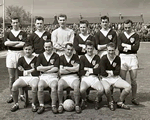 In the early 60s East Stirlingshire dropped their traditional narrow hoops in favour of black jerseys. The 1962-63 version shown here featured a very unusual collar.
In the early 60s East Stirlingshire dropped their traditional narrow hoops in favour of black jerseys. The 1962-63 version shown here featured a very unusual collar.
Rochdale (1979-80 socks corrected), Lincoln City (1993-94 corrected), Greenock Morton (1977-78 Umbro trim added to shirt; the rarely worn Adidas shirts from 1983-84 were matched with their regular Umbro shorts), Grimsby Town (crest history revised), West Ham United (1991-92, 1992-93 shorts trim corrected),(). Exeter City (1909-10, 1960-61 added).
 I was under the firm impression that Jimmy Hill was responsible for introducing the first single colour strip (other than all-white) when he had his Coventry City team kitted out in all sky-blue in 1962-63. This has now been thrown into doubt by this picture of Exeter City wearing matching red shirts and shorts in 1960-61.
I was under the firm impression that Jimmy Hill was responsible for introducing the first single colour strip (other than all-white) when he had his Coventry City team kitted out in all sky-blue in 1962-63. This has now been thrown into doubt by this picture of Exeter City wearing matching red shirts and shorts in 1960-61.
3 March
 Although it is thought that Watford played in turquoise jerseys in the 1930s, the evidence is scanty, all club records for the period having been destroyed. Recently, however, I was sent a scan of a programme from a match between Queen's Park Rangers and Watford which confirms the visitors' unusual colours.
Although it is thought that Watford played in turquoise jerseys in the 1930s, the evidence is scanty, all club records for the period having been destroyed. Recently, however, I was sent a scan of a programme from a match between Queen's Park Rangers and Watford which confirms the visitors' unusual colours.  Unfortunately my correspondent did not provide the date for the game. As I looked into this I came across two photographs that may show the jerseys in question worn in 1928-29 (above left) and 1935-36. In the course of my digging I came across this rather fine colourised image of the team wearing their splendid red, green and yellow jerseys in 1906-07.
Unfortunately my correspondent did not provide the date for the game. As I looked into this I came across two photographs that may show the jerseys in question worn in 1928-29 (above left) and 1935-36. In the course of my digging I came across this rather fine colourised image of the team wearing their splendid red, green and yellow jerseys in 1906-07.
(Photo credit: The Watford Observer)
1 March
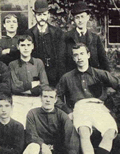 I was contacted last month by Nick Walters who curates the Wolves Shirt Museum blog concerning the team group on the left, which he had colourised based on my graphic. This has always been a puzzling image that doesn't seem to fit with what is known about Wolverhampton Wanderers' kit history from contemporary sources. The photograph appeared in The Wolves: The First Eighty Years" (Percy Young 1959) without a date attributed although in his updated 1976 history, it is described as "circa 1890." We know that
I was contacted last month by Nick Walters who curates the Wolves Shirt Museum blog concerning the team group on the left, which he had colourised based on my graphic. This has always been a puzzling image that doesn't seem to fit with what is known about Wolverhampton Wanderers' kit history from contemporary sources. The photograph appeared in The Wolves: The First Eighty Years" (Percy Young 1959) without a date attributed although in his updated 1976 history, it is described as "circa 1890." We know that 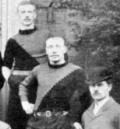 the club registered their colours for the 1891-92 season as "blue and orange" (Burnley Express 11 July 1891) but on the eve of the new season this was changed to "old-gold and black shirts, quartered," (Preston Herald 16 September 1891).
the club registered their colours for the 1891-92 season as "blue and orange" (Burnley Express 11 July 1891) but on the eve of the new season this was changed to "old-gold and black shirts, quartered," (Preston Herald 16 September 1891).
My theory is that the photograph shows the original blue and orange jerseys. However, the players all seem very young. Furthermore none of them nor the officials present in the circa 1890 photograph appear in the 1892-93 team (right). This raises the possibility that Percy Young was mistaken and the older picture is not of a Wolves team at all. Another possibility is that the blue and orange shirts were assigned to the reserves or an affiliated youth team. This remains an open question and I am very keen to hear from any Elves who can shed light on the subject.
One thing that is clear is that my interpretation of the photograph was incorrect (dark blue still appears dark when photographed with orthographic film) and I have reversed the colours in my graphic.
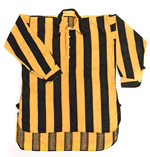 In the course of our correspondence, Nick directed me to this picture of a shirt dating from 1899, the oldest Wolves shirt to have survived. The property of Brad Gwilliam, it was worn in the 1899-1900 season by his great-grandfather, RE Gwilliam, who played for the team 1899-1902.
In the course of our correspondence, Nick directed me to this picture of a shirt dating from 1899, the oldest Wolves shirt to have survived. The property of Brad Gwilliam, it was worn in the 1899-1900 season by his great-grandfather, RE Gwilliam, who played for the team 1899-1902.
(Credits: The Wolves: The First Eighty Years" (Percy Young 1959), Brad Gwiliam/Wolves Shirt Museum.)
15 February
 Notts County (1963-64 socks corrected - see left), Accrington Stanley (1952-53 added), Accrington Stanley modern club, (2001-02, 2002-03 detailing updated), East Fife (1970-71 added), Wimbledon (1962-66 entries tidied up and 1963 FA Amateur Cup final strip added), Newcastle United (red shirts worn against Leeds United in the FA Cup, January 1931, added), Cheltenham Town (1995-96 & 1996-97 now presented in the correct order, August 1997 added),
Notts County (1963-64 socks corrected - see left), Accrington Stanley (1952-53 added), Accrington Stanley modern club, (2001-02, 2002-03 detailing updated), East Fife (1970-71 added), Wimbledon (1962-66 entries tidied up and 1963 FA Amateur Cup final strip added), Newcastle United (red shirts worn against Leeds United in the FA Cup, January 1931, added), Cheltenham Town (1995-96 & 1996-97 now presented in the correct order, August 1997 added),
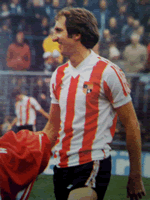 Lee Hermitage wrote to me recently enclosing this photograph of a Stoke City player warming up before an away game in 1980. "I stumbled across this variation of Stoke City's Umbro shirt with a deep, white V-neck, rather than the standard wing collar....I've never seen this version of the Stoke shirt of that era. Maybe it was only brought out at venues where Stoke needed to change from white shorts/socks?"
Lee Hermitage wrote to me recently enclosing this photograph of a Stoke City player warming up before an away game in 1980. "I stumbled across this variation of Stoke City's Umbro shirt with a deep, white V-neck, rather than the standard wing collar....I've never seen this version of the Stoke shirt of that era. Maybe it was only brought out at venues where Stoke needed to change from white shorts/socks?"
Stoke are indeed wearing their alternative black shorts but this is not the reason for the unusual shirt. In 1980 the TV companies were refusing to televise matches in which teams wore sponsored shirts. To avoid being blacklisted, clubs ordered at least one set of shirts without sponsorship. No doubt it was easier and cheaper to get Umbro to supply these with their standard broad V neck rather than the bespoke flappy collar that featured on their regular set.
(Photo Credit: Aston Villa official match programme December 1980.)
10 February
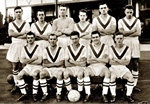 I have given the original Airdrieonians section an early spring clean, mainly to render their iconic diamond more accurately. The photograph is of the 1959-60 team.
I have given the original Airdrieonians section an early spring clean, mainly to render their iconic diamond more accurately. The photograph is of the 1959-60 team.
Wrexham (1984-85 European kit added, Sept 2001-02 branding changed).
In the course of their research, HFK elves Tony Sealey and Richard Essen discovered that when Tottenham Hotspur played Swansea  Town at Vetch Field on 10 November, 1928, the visitors wore red tops in the first half, blue in the second. Spurs change strip at the time (pictured right) would have been perfectly alright for the game so it appears that they either packed the wrong kit or the hamper went astray on the journey. Swansea's change shirts at the time were maroon but all reports refer to Spurs wearing red in the first half so it is likely these were sourced from somewhere else. Changing shirts at half-time was not unusual (it rained heavily that day) but
Town at Vetch Field on 10 November, 1928, the visitors wore red tops in the first half, blue in the second. Spurs change strip at the time (pictured right) would have been perfectly alright for the game so it appears that they either packed the wrong kit or the hamper went astray on the journey. Swansea's change shirts at the time were maroon but all reports refer to Spurs wearing red in the first half so it is likely these were sourced from somewhere else. Changing shirts at half-time was not unusual (it rained heavily that day) but 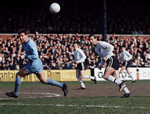 why they changed into blue tops is a mystery. If anyone can shed light on all this, please let me know.
why they changed into blue tops is a mystery. If anyone can shed light on all this, please let me know.
I have often been puzzled by the number of variations on Coventry City's sky blue kit that appeared in the late 1960s. Jim Brown has now confirmed that most of these were worn in the latter part of the 1967-68 season. The variant on the left was adopted in March 1968 and worn until the end of the season. The familiar version with blue and white rings at collar and cuff was reinstated at the start of 1968-69.
9 February
My apologies for the apparent lack of activity over the last three weeks. I've been working on a major project which I hope to publish by the end of the month. However, today I'm taking a break to catch up with some of the material in the 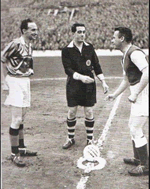 HFK inbox beginning with some more Scottish updates from Ian McConnel.
HFK inbox beginning with some more Scottish updates from Ian McConnel.
In April 1958 Rangers wore "silk" tops in their match against Hibernian, shown here. They also seem to have adopted a warm weather top that season which featured a contrasting V neck and short sleeves for the first time.
Clyde (1955 Scottish Cup final socks corrected, 1956-57 & 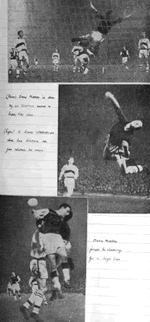 1957-58 socks detailing modified), Dunfermline Athletic (1955-57 cold weather kit modified, 1955-58 kits tidied up), East Fife (1956-57 socks corrected, 1957-59 detailing amended), Dundee (1956-57 added, 1957-58 crest amended), Airdrieonians (1956-57 two strips added, 1957-58 cold weather strip added), Stirling Albion (1956-57 added), Kilmarnock (1957-58, 1959-61 added), Queen's Park (1957-58 added), Falkirk (1957-59 shorts trim added), Raith Rovers (Jan-May 1958 detailing adjusted), St Mirren (1957-58, 1958-59 stripes adjusted), Dundee United (1957-58 shorts & socks corrected), Inverness Caledonian (1957-58 added).
1957-58 socks detailing modified), Dunfermline Athletic (1955-57 cold weather kit modified, 1955-58 kits tidied up), East Fife (1956-57 socks corrected, 1957-59 detailing amended), Dundee (1956-57 added, 1957-58 crest amended), Airdrieonians (1956-57 two strips added, 1957-58 cold weather strip added), Stirling Albion (1956-57 added), Kilmarnock (1957-58, 1959-61 added), Queen's Park (1957-58 added), Falkirk (1957-59 shorts trim added), Raith Rovers (Jan-May 1958 detailing adjusted), St Mirren (1957-58, 1958-59 stripes adjusted), Dundee United (1957-58 shorts & socks corrected), Inverness Caledonian (1957-58 added).
As an added bonus, Ian has found some photographs of the floodlit match between Newcastle United and Heart of Midlothian played on 20 November 1957. This allows us to finally confirm all the details of Toon's elusive floodlights kit. Hearts wore their own floodlights shirts with white sleeves.
(Photo Credit: Ian McConnel)
15 January - Huddersfield Town (Again)
 In the course of my update of the Huddersfield Town section earlier this week, I dropped the April 1912 graphic because I was unable to find the source. After consulting with Roger Pashby, I found the email (which dates from ten years ago!) in which he sent me the photographs shown here. The tops are clearly the team's change strip and the fact that they are worn in home matches is not in itself significant. At the time the "senior" club retained their first choice strip when colours clashed and it was not until 1921 that the Football League introduced the rule requiring visiting teams to change.
In the course of my update of the Huddersfield Town section earlier this week, I dropped the April 1912 graphic because I was unable to find the source. After consulting with Roger Pashby, I found the email (which dates from ten years ago!) in which he sent me the photographs shown here. The tops are clearly the team's change strip and the fact that they are worn in home matches is not in itself significant. At the time the "senior" club retained their first choice strip when colours clashed and it was not until 1921 that the Football League introduced the rule requiring visiting teams to change.
What is significant is that the image on the right is from the match against Hull City on 9 April 1912. There is no reason for Huddersfield to change out of their normal white shirts for this game but it came over the Easter period at the end of a sequence of four matches in five days. In fact the teams had met the previous day at Anlaby Road and it seems likely that there was no time to get their white shirts washed and dry in time after they returned to Huddersfield.
(Credit: Leeds Road: Home of my Dream (Ian Thomas 1994) retrieved from The Huddersfield Town Collection).
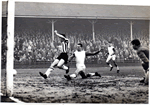 Jim Brown has sent me evidence that Coventry City adopted the white strips with contrasting blue sleeves in November 1961. The photograph shows them wearing this unusual outfit at Notts County in January 1962. It is well documented that they also had an all-white strip with V necks and short sleeves in 1961-62 which I believe was worn in the warmer months.
Jim Brown has sent me evidence that Coventry City adopted the white strips with contrasting blue sleeves in November 1961. The photograph shows them wearing this unusual outfit at Notts County in January 1962. It is well documented that they also had an all-white strip with V necks and short sleeves in 1961-62 which I believe was worn in the warmer months.
Rotherham United (1949-51, 1951-52 detailing updated).
13 January - Boston United
 I'm grateful to Christian James who has sent me a collection of photographs to improve the Boston United section. (1957-58 socks corrected, 1965-66, 1970-71 added, 1973-77 socks corrected, 1980-81 added, 1981-82 collar corrected, 1978-80 sponsorship added, 1983-84 & 1985-86 added, 1986-87 & 1987-88 sponsor corrected, 1990-91 detailing added, 2000-01 shorts corrected.) Pictured is the 1959-60 team.
I'm grateful to Christian James who has sent me a collection of photographs to improve the Boston United section. (1957-58 socks corrected, 1965-66, 1970-71 added, 1973-77 socks corrected, 1980-81 added, 1981-82 collar corrected, 1978-80 sponsorship added, 1983-84 & 1985-86 added, 1986-87 & 1987-88 sponsor corrected, 1990-91 detailing added, 2000-01 shorts corrected.) Pictured is the 1959-60 team.
12 January - Huddersfield Town Major Update
 An enduring puzzle that goes back to the very beginning of HFK has been how to interpret early photographs of Huddersfield Town, such as this example from 1913-14. The stripes appear to be quite pale and initially I thought they must have been light blue although the few contemporary records I was able to find consistently described their
An enduring puzzle that goes back to the very beginning of HFK has been how to interpret early photographs of Huddersfield Town, such as this example from 1913-14. The stripes appear to be quite pale and initially I thought they must have been light blue although the few contemporary records I was able to find consistently described their 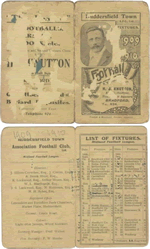 colours as "blue and white." Once the role of the orthographic film stock, widely used at the time was understood (it makes blues look pale and reds/yellows dark), I revised my graphics to show conventional mid-blue.
colours as "blue and white." Once the role of the orthographic film stock, widely used at the time was understood (it makes blues look pale and reds/yellows dark), I revised my graphics to show conventional mid-blue.
Recently Roger Pashby, who runs the outstanding Huddersfield Town Collection website, sent me a photograph of this 1909-10 fixture card, the season that the club dropped their original red jerseys and it clearly states that the new colours would be "light blue and white."
Armed with this information I have re-examined the photographic record and concluded that the club wore a shade that was intermediate between pale "Cambridge Blue" and conventional mid or royal blue. I believe they switched to mid blue and white shortly before the outbreak of the Second World War, although I can't be certain about this.
As a result I have completely overhauled the Huddersfield Town section that includes alterations and additional detailing to graphics up to 1962.
(Credits: Huddersfield Town Collection)
11 January - Scottish Clubs Update
 Aberdeen (1954-55 added), East Fife (1953-55 detailing corrected, 1955-56added), Heart of Midlothian (1954-55 alternative kit added), Dundee (1954-55 added, 1955-56 detailing added), Airdrieonians (1954-55 early season kit added), Raith Rovers (1954-55 corrected), Clyde (1954-55 corrected - the kit with a crest was worn only in the Scottish Cup final, 1955-56 warm weather kit added), St Johnstone (1954-55 shorts detailing adjusted), Dunfermline Athletic (1954-55 corrected, 1955-57 kits now designated for warm or cold weather), Rangers (1937-50 change kit corrected), St Mirren (detailing adjusted).
Aberdeen (1954-55 added), East Fife (1953-55 detailing corrected, 1955-56added), Heart of Midlothian (1954-55 alternative kit added), Dundee (1954-55 added, 1955-56 detailing added), Airdrieonians (1954-55 early season kit added), Raith Rovers (1954-55 corrected), Clyde (1954-55 corrected - the kit with a crest was worn only in the Scottish Cup final, 1955-56 warm weather kit added), St Johnstone (1954-55 shorts detailing adjusted), Dunfermline Athletic (1954-55 corrected, 1955-57 kits now designated for warm or cold weather), Rangers (1937-50 change kit corrected), St Mirren (detailing adjusted).
 Pictured are the matches between St Mirren and Aidrieonians in 1955-56 (top left) and Dundee v Rangers (lower right) at Dens Park on 30 December 1950. In Scotland it was the home team that changed when colours clashed which is why Dundee are wearing white shirts so it is not clear why the visitors have also changed into their unusual alternative tops.
Pictured are the matches between St Mirren and Aidrieonians in 1955-56 (top left) and Dundee v Rangers (lower right) at Dens Park on 30 December 1950. In Scotland it was the home team that changed when colours clashed which is why Dundee are wearing white shirts so it is not clear why the visitors have also changed into their unusual alternative tops.
6 January
Euro 1984: Yugoslavia (trim adjusted on all strips).
FIFA World Cup 1998: Yugoslavia (1998 red trim added).
Lincoln City (1989-90 detailing added). Tony Sealey has unravelled the confusing sequence of kits worn by Wimbledon between 1972 and 1975.
5 January
 My thanks to Michael Gluck for this photograph, which shows that Bradford City adopted these smart broad striped shirts in 1938-39, earlier than I had previously thought.
My thanks to Michael Gluck for this photograph, which shows that Bradford City adopted these smart broad striped shirts in 1938-39, earlier than I had previously thought.
The Lancashire Evening Post (16 May 1906) reported that the directors of Grimsby Town had decided to 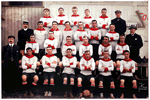 change the team's colours to "white jerseys, with a bright red collar and waistband, black knickers, and black stockings, with red tops." This colourised photograph, taken the following season (1907-08) provides a good view of this curious collar but there is no sign of a waistband. We think this was a misprint for "wristband."
change the team's colours to "white jerseys, with a bright red collar and waistband, black knickers, and black stockings, with red tops." This colourised photograph, taken the following season (1907-08) provides a good view of this curious collar but there is no sign of a waistband. We think this was a misprint for "wristband."
(Credit: British Newspaper Archive retrieved by Dave Wherry)
Arsenal (1919-20 socks revised), Bootle (1892-93 added), Burton Wanderers (1896-97 added), Lincoln City (1896-97 confirmed as dark red and white).
4 January 2021
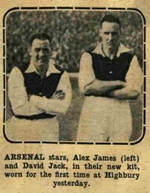 In July 2013, drawing on the research of Mark Andrews and Andy Kelly I published the story of how Herbert Chapman first created the iconic Arsenal shirt in 1933 by ordering a set of sleeveless Viyela jumpers to be worn over the top of their white change shirts. You can read the full story on the History of Arsenal Blog.
In July 2013, drawing on the research of Mark Andrews and Andy Kelly I published the story of how Herbert Chapman first created the iconic Arsenal shirt in 1933 by ordering a set of sleeveless Viyela jumpers to be worn over the top of their white change shirts. You can read the full story on the History of Arsenal Blog.
Last month Tony Sealey alerted me to the fact that in the new edition of The Arsenal Shirt (Simon Shakeshaft & James Elkin 2020) a slightly different narrative emerges. According to reports in the Nottingham Evening Post and the Daily Mirror (4 March  1933) Arsenal were expected to wear the jumper and shirt combination against Liverpool at Highbury that afternoon. The cutting on the right (Nottingham Journal 6 March 1933) confirms the team wore their new colours that afternoon but the photograph (above left) from the Sunday Pictorial (5 March 1933) clearly shows Alex James and David Jack wearing conventional flannel shirts.
1933) Arsenal were expected to wear the jumper and shirt combination against Liverpool at Highbury that afternoon. The cutting on the right (Nottingham Journal 6 March 1933) confirms the team wore their new colours that afternoon but the photograph (above left) from the Sunday Pictorial (5 March 1933) clearly shows Alex James and David Jack wearing conventional flannel shirts.
According to The Arsenal Story (Tom Whittaker 1957), the jumper and shirt combination proved troublesome in the wash and was rejected in favour of a more conventional solution. The club had been given permission to 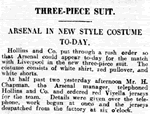 change their colours on 21 February and I assume the experimental tops were tried out in training and found wanting so conventional red and white flannel shirts were ordered to replace them. I've been able to confirm that in the two matches played after permission for the change was granted, the Gunners wore their plain red tops so we can certain that the new colours were indeed introduced on 4 March.
change their colours on 21 February and I assume the experimental tops were tried out in training and found wanting so conventional red and white flannel shirts were ordered to replace them. I've been able to confirm that in the two matches played after permission for the change was granted, the Gunners wore their plain red tops so we can certain that the new colours were indeed introduced on 4 March.
What remains puzzling, however, is that the Nottingham Evening Post (4 March 1933) reported that Chapman contacted Hollins & Co to place a rush order for the Viyella jumpers the day before the Liverpool game.
(Credits: The British Newspaper Archives)

